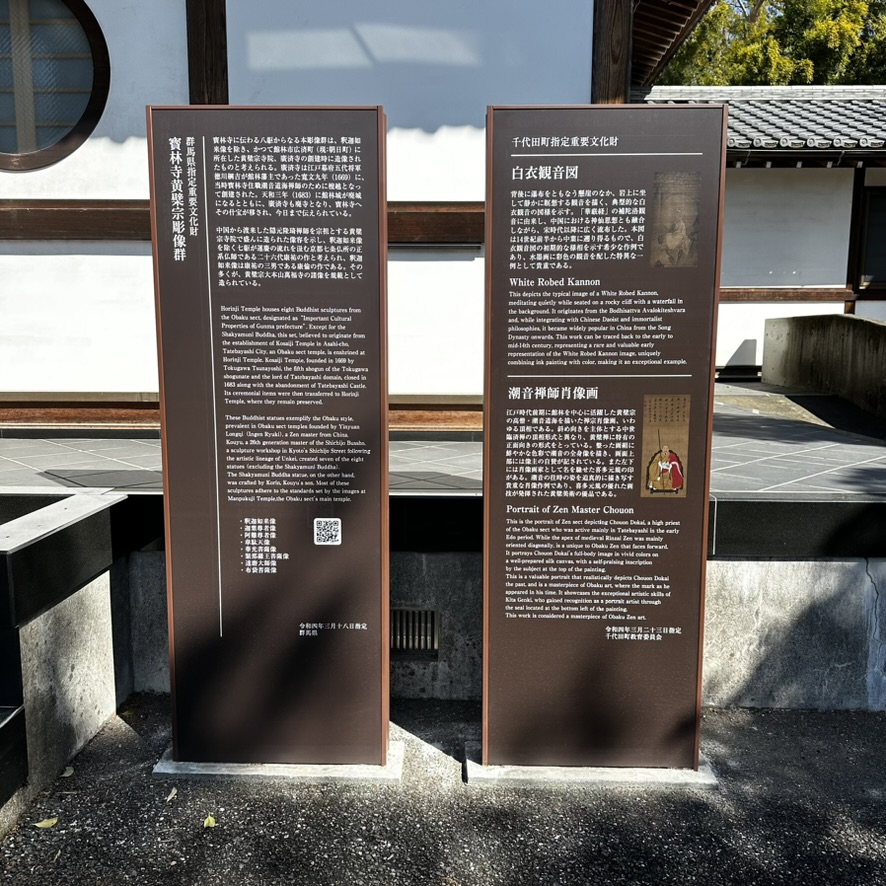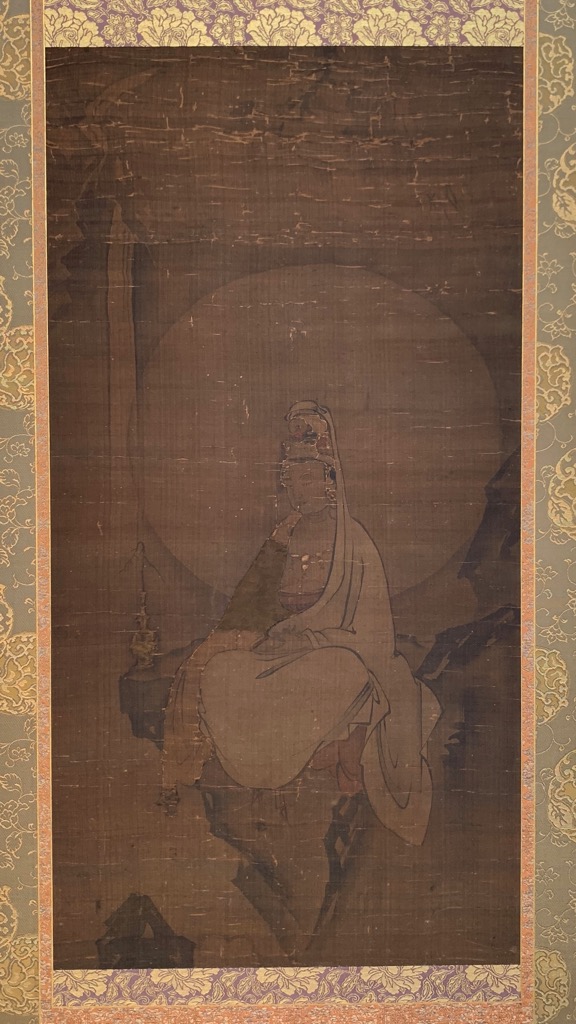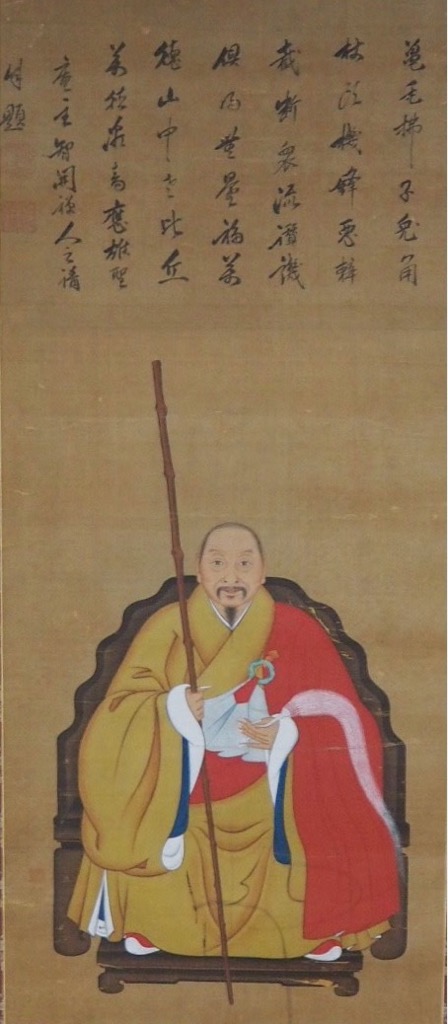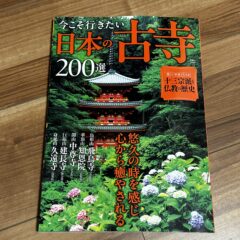文化財の案内看板が設置されました!

群馬県及び千代田町教育委員会のご尽力により、この度重要文化財の看板が設置することができました。
設置にご協力いただきました方々にこの場を借りて御礼申し上げます。
ぜひ宝林寺へ足をお運びの際は、ご覧くださいませ。
群馬県指定重要文化財|寳林寺黄檗宗彫像群
寳林寺に伝わる八躯からなる本彫像群は、釈迦如来像を除き、かつて館林市広済町(現:朝日町)に所在した黄檗宗寺院、廣済寺の創建時に造像されたものと考えられる。廣済寺は江戸幕府五代将軍徳川綱吉が館林藩主であった寛文九年(1669)に、当時寳林寺住職潮音道海禅師のために檀越となって創建された。天和三年(1683)に館林城が廃城になるとともに、廣済寺も廃寺となり、寳林寺へその什宝が移され、今日まで伝えられている。
中国から渡来した隠元隆琦禅師を宗祖とする黄檗宗寺院で盛んに造られた像容を示し、釈迦如来像を除く七躯が運慶の流れを汲む京都七条仏所の正系仏師である二十六代康祐の作と考えられ、釈迦如来像は康祐の三男である康倫の作である。その多くが、黄檗宗大本山萬福寺の諸像を規範として造られている。
Horinji Temple houses eight Buddhist sculptures from the Obaku sect, designated as “Important Cultural Properties of Gunma prefecture”. Except for the Shakyamuni Buddha, this set, believed to originate from the establishment of Kosaiji Temple in Asahi-cho,Tatebayashi City, an Obaku sect temple, is enshrined at Horinji Temple. Kosaiji Temple, founded in 1669 by Tokugawa Tsunayoshi, the fifth shogun of the Tokugawa shogunate and the lord of Tatebayashi domain, closed in 1683 along with the abandonment of Tatebayashi Castle. Its ceremonial items were then transferred to Horinji
Temple, where they remain preserved. These Buddhist statues exemplify the Obaku style,prevalent in Obaku sect temples founded by Yinyuan Longqi(Ingen Ryuki), a Zen master from China. Kouyu, a 26th generation master of the Shichijo Bussho, a sculpture workshop in Kyoto’s Shichijo Street following the artistic lineage of Unkei, created seven of the eight statues (excluding the Shakyamuni Buddha). The Shakyamuni Buddha statue, on the other hand, was crafted by Korin, Kouyu’s son. Most of these sculptures adhere to the standards set by the images at Manpukuji Temple,the Obaku sect’s main temple.
千代田町指定文化財|白衣観音図及び潮音禅師肖像画

白衣観音図
背後に瀑布をともなう懸崖のなか、岩上に坐して静かに瞑想する観音を描く、典型的な白衣観音の図様を示す。「華厳経」の補陀洛観音に由来し、中国における神仙思想とも融合しながら、宋時代以降に広く流布した。本図は14世紀前半から中葉に遡り得るもので、白衣観音図の初期的な様相を示す希少な作例であり、水墨画に彩色の観音を配した特異な一例として貴重である。
This depicts the typical image of a White Robed Kannon,meditating quietly while seated on a rocky cliff with a waterfall in the background. It originates from the Bodhisattva Avalokiteshvara and, while integrating with Chinese Daoist and immortalist philosophies, it became widely popular in China from the Song Dynasty onwards. This work can be traced back to the early to mid-14th century, representing a rare and valuable early representation of the White Robed Kannon image, uniquely combining ink painting with color, making it an exceptional example.

潮音禅師肖像画
江戸時代前期に館林を中心に活躍した黄檗宗の高僧・潮音道海を描いた禅宗肖像画、いわゆる頂相である。斜め向きを主体とする中世臨済禅の頂相形式と異なり、黄檗禅に特有の正面向きの形式をとっている。整った画絹に鮮やかな色彩で潮音の全身像を描き、画面上部には像主の自賛が記されている。また左下には肖像画家として名を馳せた喜多元規の印がある。潮音の往時の姿を迫真的に描き写す貴重な肖像作例であり、喜多元規の優れた画技が発揮された黄檗美術の優品である。
This is the portrait of Zen sect depicting Chouon Dokai, a high priest of the Obaku sect who was active mainly in Tatebayashi in the early Edo period. While the apex of medieval Rinzai Zen was mainly oriented diagonally, is a unique to Obaku Zen that faces forward. It portrays Chouon Dokai’s full-body image in vivid colors on a well-prepared silk canvas, with a self-praising inscription by the subject at the top of the painting. This is a valuable portrait that realistically depicts Chouon Dokai the past, and is a masterpiece of Obaku art, where the mark as he appeared in his time. It showcases the exceptional artistic skills of Kita Genki, who gained recognition as a portrait artist through the seal located at the bottom left of the painting. This work is considered a masterpiece of Obaku Zen art.






